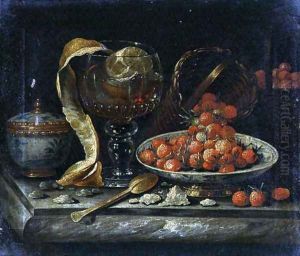(manner of) Roestraten, Pieter Gerritsz. van Paintings
Pieter Gerritsz. van Roestraten was a Dutch Golden Age painter, born in Haarlem in 1630. He is often referred to in the 'manner of' because while he developed a style of his own, he was heavily influenced by other artists, particularly his teacher Frans Hals, who was one of the most famous painters of the era. Roestraten's early work was in the realm of portraiture, where he brought Hals's influence to bear with a loose style and a focus on capturing the liveliness of the subject.
Roestraten moved to London in 1666, just after the Great Fire, where he would spend the rest of his life. In London, he became known for his still life paintings, particularly those depicting elaborate arrangements of luxury goods such as silverware, glassware, and musical instruments. These paintings showcased his skill in rendering textures and reflective surfaces, a testament to his meticulous technique and attention to detail. His work in this genre was influenced by the likes of Willem Kalf and Pieter Claesz, who were known for their own sumptuous still life works.
Beyond his still lifes, Roestraten also painted 'vanitas' pieces, which contain symbolic objects designed to remind viewers of the transience of life, the futility of pleasure, and the certainty of death. This theme was common among Dutch Golden Age artists and reflected the Calvinist cultural context of the time.
Despite his success and the quality of his work, Roestraten has not maintained the same level of fame as some of his contemporaries. However, his paintings can still be found in art collections and museums, and they offer a valuable perspective on the trends and styles that characterized the art scene in the Netherlands and England during the 17th century. Pieter Gerritsz. van Roestraten died in London in 1700, leaving behind a body of work that continues to be studied and appreciated for its contribution to the Dutch Golden Age of painting.
